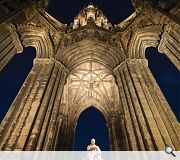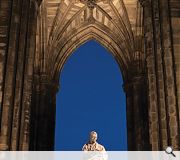Scott Monument External Lighting
The initial site visit to the Scott Monument conjured up images of Jack and the Beanstalk, faced with an imposing blackened tower, crowded with illegible Gothic detailing. Both dominating and delicate, a new lighting scheme was needed to bring the Scott Monument back to life.
The masonry is immensely fragile and conservation requirements are rigid, therefore we restricted our brief to using existing mounting points. We endeavoured to avoid additional punctures that could cause cracking or structural issues in the future.
We visualised our concept in real scale, testing various colour temperatures, beam angles and LED lamp options directly onto the monument. It became apparent that the monument itself would drive our concept. Essentially the stone decided where and how we should use light. It sparkles under the Xicato. Separated Phosphor technology. Not the Artist or Vibrant range, they both created a greenish tint to the masonry. Only the standard 83 Ra module would suit. We punctuated this with direct sources to the crown and Sir Walter Scott statue. The light glides over the stonework, defining key architectural features. Our final design includes eight additional doubled-headed custom bollards.This allows the base of the monument to be illuminated, linking the structure with its urban surroundings, the people of Edinburgh and visitors to the city.
Is the new scheme more efficient? We have designed the majority of luminaires with a local manufacturer, who fabricated the fittings in Edinburgh. The luminaries can all be maintained from the monument itself. Each beam angle has been visually tested to graze the stonework in a controlled and sympathetic manner, revealing forgotten features. Comparing the new scheme with the historic one, watt per watt, the new scheme has modestly reduced the electrical load but greatly reduced energy consumed through re-lamping and access equipment.
The masonry is immensely fragile and conservation requirements are rigid, therefore we restricted our brief to using existing mounting points. We endeavoured to avoid additional punctures that could cause cracking or structural issues in the future.
We visualised our concept in real scale, testing various colour temperatures, beam angles and LED lamp options directly onto the monument. It became apparent that the monument itself would drive our concept. Essentially the stone decided where and how we should use light. It sparkles under the Xicato. Separated Phosphor technology. Not the Artist or Vibrant range, they both created a greenish tint to the masonry. Only the standard 83 Ra module would suit. We punctuated this with direct sources to the crown and Sir Walter Scott statue. The light glides over the stonework, defining key architectural features. Our final design includes eight additional doubled-headed custom bollards.This allows the base of the monument to be illuminated, linking the structure with its urban surroundings, the people of Edinburgh and visitors to the city.
Is the new scheme more efficient? We have designed the majority of luminaires with a local manufacturer, who fabricated the fittings in Edinburgh. The luminaries can all be maintained from the monument itself. Each beam angle has been visually tested to graze the stonework in a controlled and sympathetic manner, revealing forgotten features. Comparing the new scheme with the historic one, watt per watt, the new scheme has modestly reduced the electrical load but greatly reduced energy consumed through re-lamping and access equipment.
PROJECT:
Scott Monument External Lighting
LOCATION:
Princes Street, Edinburgh
CLIENT:
City of Edinburgh Council
Suppliers:
Main Contractor:
McGill Electrical
Lighting:
Kevan Shaw Lighting Design
Photographer:
David Barbour
Back to Historic Buildings & Conservation
Browse by Category
Building Archive
- Buildings Archive 2023
- Buildings Archive 2022
- Buildings Archive 2021
- Buildings Archive 2020
- Buildings Archive 2019
- Buildings Archive 2018
- Buildings Archive 2017
- Buildings Archive 2016
- Buildings Archive 2015
- Buildings Archive 2014
- Buildings Archive 2013
- Buildings Archive 2012
- Buildings Archive 2011
- Buildings Archive 2010
- Buildings Archive 2009
- Buildings Archive 2008
- Buildings Archive 2007
- Buildings Archive 2006
Submit
Search
Features & Reports
For more information from the industry visit our Features & Reports section.





